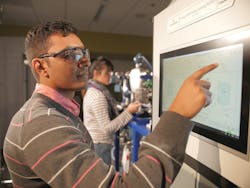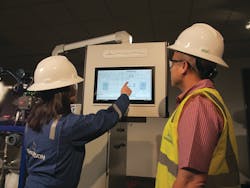A: With the growth of technology and digitization, jobs are getting highly specialized and automated. The type of skills required are changing. New digital technologies are disrupting the business landscape with major consequences for how industries are structured and economic activity occurs. Studies are showing that advanced manufacturers could create up to 3.5 million job openings by 2025, yet nearly 2 million of those jobs may go unfilled for lack of the right skills to meet modern manufacturing demands.
The working age population is growing at half the rate of the past century, and baby boomers are retiring in record numbers. Manufacturers are struggling to find the talent needed to run their plant. There is a great need to feed a pipeline of new workers who see manufacturing jobs as viable and a successful career path both for the highly skilled engineer as well as the process instrumentation tech.
Q: What job requirements does the current and future industrial workforce lack?
A: They lack knowledge of the latest technologies being used in advanced manufacturing plants to maximize production, increase reliability, save energy and lower operating costs. Also, even the most advanced engineers are leaving college with no hands-on experience or real-time knowledge of how to work a plant. This applies to both new workers entering the job field and existing employees at a plant, so upskilling existing workers is also critical.
Other skill sets needed in today’s digitally transformed organization include data scientists/analytics, cybersecurity expertise and those harder-to-define but critical soft skills such as communication and leadership.
Q: What are the opportunities in upskilling the current and future workforce?
A: Adopting approaches that empower workers to acquire knowledge and experience faster and more effectively ensures they have access to training in flexible formats to increase proficiency with the technology and processes with which they interact. Collaborating with higher education institutions and industry helps attract people entering the workforce to the industry as well as facilitates programs that help train current and future workers.
When you look at ways to upskill, you become a vital part of transforming the workforce for both current and future employees. This gives you the opportunity to expand on partnerships and attract top talent. You will find that when you invest in your employees, retention will improve because their knowledge and expertise is increasing. This type of approach and strategy is a major resource as digital transformation makes a mark in the manufacturing industry.Constantly looking for innovative approaches in training and upskilling provides excitement and interest that grow the pipeline for the manufacturing sector.
Q: How is Emerson addressing the skills gap challenge?
A: Emerson is continually investing in new and innovative approaches to meet the skills gap challenge. We have invested in a manufacturing incubator facility at Ranken Technical College in St. Louis and have increased partnerships with colleges and universities across various sectors, increasing engineers’ exposure to the latest technologies at various schools.
In addition, Emerson Educational Services is designing and implementing workforce development solutions for many different plant personnel, ranging from maintenance technicians to operations to engineering. We also introduced the Performance Learning Platform in late 2018, as a portable and compact automation technology training solution that enables hands-on training and has innovative capabilities like augmented reality and virtual reality. It reinforces the competencies essential to fostering digital transformation.
As a global industry educator, Emerson is helping customers upskill and leverage their technology investments with over 100 learning centers around the world and nearly 500 instructors, training over 28,000 people annually. More than 300 courses are delivered in person or via a live, instructor-led virtual classroom.
For example, Emerson has recently partnered with Colorado State University, Rutgers, Texas A&M, Singapore Polytechnic, and San Jacinto College, to name a few, on both industry and role-specific programs to support incumbent worker training as well as new workforce training. Emerson has also developed numerous workforce upskilling programs for multinational companies to help address specific leadership skills gaps within those respective organizations as part of broader leadership development programs.
Q: What are the benefits of companies such as Emerson in collaborating with educational institutions or offering training to its current employees?
A: The growing talent gap will not be solved by any single strategy alone. Collaborating with academia, policy-makers and industry will accelerate solutions to solving these workforce challenges. Emerson’s commitment to the industry as a leader in developing the workforce of the future is key to not only our customers, but also to our own workforce needs. We understand that engineering graduates will be the future decision-makers in industries that Emerson serves and feed into our own talent pipeline.
Q: How do training methods differ with the younger generation entering the workforce to mature professionals?
A: What they both have in common is the need to have hands-on real working process instrumentation experience (in a safe environment) to understand the fundamentals from inputs and outputs, configuration and troubleshooting. Mature professionals bring a lot of experience to the table, so understanding their specific skills gaps and designing content for those gaps is most effective. While digital technologies are native to the future generation of workers, it is important to use innovative learning methods, such as virtual reality or gaming theory, to give the next generation of workers the experience they need in the methods/formats they prefer.Q: Tell us more about Emerson’s Performance Learning Platform (PLP). How does it work?
A: Emerson visited many college campuses over an 18-month period, collecting information about what lab equipment and curriculum colleges needed. We also asked our end-user plant managers and E&I supervisors about their workforce development challenges. Emerson then created an internal development team that worked for about 12 months on the overall PLP design, fabrication and curriculum. We designed the PLP for portability and plug and play operation. You add water to the tanks, hook up a compressed air supply for the valves, and plug in the power. The robust frame is mounted on industrial casters to make it easy to relocate. It will also fit through a normal 30-inch doorway.
The PLP recirculates water (at low pressure) between two 35-gallon tanks. We are measuring and controlling tank level and flow rate using the latest technologies. The PLP also includes a DeltaV distributed control system, Emerson’s latest PK controller, electronic marshalling and CHARMS. The HMI is a Pro+ touchscreen workstation mounted on a swiveling strong arm. We’ve made it safe and easy to use. It’s a lot of automation on a very small, portable footprint.
Coming soon are augmented reality features and a virtual reality-based PLP digital twin. And, you can learn more about how it works at www.emerson.com/plp.
Q: What are the benefits of having the PLP?
A: The PLP enables hands-on training using the latest automation technologies. It can be used to teach the fundamentals to new employees and college students, and it can be used to teach more advanced topics like loop tuning and troubleshooting. It can also be customized with the specific instrumentation that is relevant at the plant. It is also a portable and scalable solution that makes it ideal for both a classroom setting and in a manufacturing facility.
The PLP is also supported with its own curriculum that includes: PLP Performance Support Videos, over 50 videos available directly from the workstation covering many common tasks associated with each device; a PLP Lab Book, over 300 pages of industry best practices and over 20 hands-on exercises including the answer key; and eLearning courses. Plus, augmented and virtual reality were just debuted at Emerson Exchange 2019 last September. Although it is still in development, feedback has been very good so far.
Q: Since the PLP was released, who is using it?
A: Emerson has provided the PLP to several universities, trade schools and end users since it became available. In addition to colleges, the PLP can be used to train incumbent workers at manufacturing companies in many different industries including oil and gas, chemical and petrochemical, food and beverage, and metals and mining.





